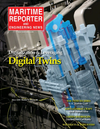
Page 35: of Maritime Reporter Magazine (June 2024)
Read this page in Pdf, Flash or Html5 edition of June 2024 Maritime Reporter Magazine
GREEN HYDROGEN
Accelera by Cummins leadership and distinguished guests cut the ribbon at the opening of Accelera’s ? rst electrolyzer production site in the U.S.
In April, Fortescue of? cially opened an electrolyzer manufacturing facility in Australia – one of the ? rst globally to house an automated assembly line.
Image courtesy of Fortescue Image courtesy of Accelera able energy like PEM, pressurized alkaline and anion ex- produce two to three times more hydrogen than a conventional change membrane (AEM) and those suited to grid power or stack, enabling more hydrogen production at peak production being incorporated into industrial plant like atmospheric alka- times and capitalizing upon lower electricity prices,” says Jen- line and solid oxide electrolysis (SOE). sen. “During these moments, the exact energy consumption is
SOE is a growing technology that can also operate in re- not important, as the electricity price is low anyway. It is then a verse to act as a fuel cell, and AEM, a development of the matter of how much hydrogen you can produce by fully utiliz-
PEM concept but with cheaper materials, is an emerging ing the renewable sources available.” The technology is also technology. While alkaline electrolyzers use a liquid elec- more compact and safer than traditional PEM electrolyzers due trolyte, and PEM electrolyzers use a polymer electrolyte, to built-in air circulation to prevent combustion, she says.
SOE use a solid-state ceramic electrolyte and requires heat Another project, the EU-Funded HyScale project, aims to operate. But new variations on existing themes continue to to upscale an ef? cient, durable, sustainable, and cost-effec- emerge as the industry tackles cost and scalability challenges, tive AEM electrolyzer technology. Project partner CENmat and each have different materials, chemistries and heat and claims to have re-engineered electrolysis from scratch to pressure requirements. produce a system that operates with catalysts and electrodes
Using solar and wind energy, green hydrogen can be pro- free of critical raw materials and anion exchange membranes duced at peak times by running electrolyzers and then stor- free of forever chemicals.
ing the hydrogen for later. “Here, there’s an important role Australia’s research organization CSIRO is developing both to play for green hydrogen which can operate at a different PEM and SOE technology. Its high-ef? ciency tubular SOE scale to batteries to balance out ? uctuations in the supply of, technology uses a series of sintered ceramic tubes and easily and demand for, renewable energy production,” says Synne obtainable metals and can ef? ciently produce hydrogen and
Myhre Jensen, Public Affairs Advisor at Norwegian hydro- syngas (a mixture of hydrogen and carbon monoxide) – some- gen company Hystar. As part of the company’s HyPilot proj- thing that distinguishes it from existing PEM and alkaline ect, collaborator Equinor is planning to demonstrate dynamic technologies. It is also highly scalable.
hydrogen production tailored to the variable output typically “There is a limit to what extent ef? ciency of electrolyzers found in offshore wind applications. can be further improved,” says Dr Sarb Giddey, Senior Prin-
Johnson Matthey will supply membrane electrode assemblies cipal Research Scientist and Group Leader at CSIRO. “The for Hystar’s patented PEM technology. “Each of our stacks can ef? ciency will stay in the 70-75% range maximum due to www.marinelink.com 35
MR #6 (34-44).indd 35 6/3/2024 11:51:11 AM

 34
34

 36
36
